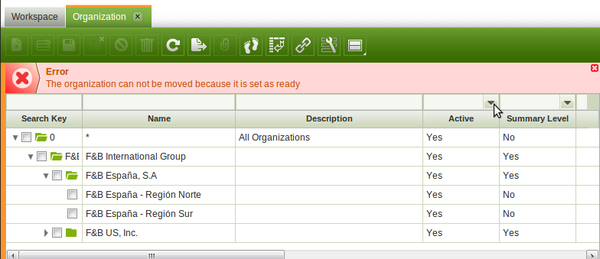How to Restrict the Movements of Nodes in a Tree
Contents
Introduction
The Tree Grid View allows to move a node to another parent or to another position within its current parent node.
Some trees might have some restrictions on how a node can be moved to another position of the tree. For instance, the Organization tree does not allow to move a node if it belongs to an organization that is ready, and the Menu tree does not allow to move a node if it belongs to a menu item whose module is not in development.
Developers can restrict the node movements or a particular tree by subclassing the CheckTreeOperationManager class.
CheckTreeOperationManager class
Overwriting the checkNodeMovement method
The CheckTreeOperationManager is an abstract class that exposes one method:
<source lang="java"> public abstract ActionResponse checkNodeMovement(Map<String, String> parameters, String nodeId,
String newParentId, String prevNodeId, String nextNodeId);
</source>
This method checks if a particular node movement is valid. It has the following paramenters:
- parameters: parameters sent from the tree grid to the TreeDatasourceService.
- nodeId: id of the node being moved.
- newParentId: id of new parent of the node being moved.
- prevNodeId, nextNodeId: ids of the nodes that will be respectively before and after the node if the movement is valid.
The checkNodeMovement method returns an object of utility class called ActionResponse, which has three attributes:
<source lang="java"> private boolean success;
private String messageType; private String message;
</source>
The success attribute represents if the node movement is valid. The messageType and message attributes can be used to show a message in the client message bar regardless of the validity of the node movement.
The checkNodeMovement method is executed by the TreeDatasourceService after each node movement if a CheckTreeOperationManager has been defined for the tree the node belongs to. If the checkNodeMovement method returns an ActionResponse with success = true, then the node movement will be commited and the node will be shown in the client side in its updated position. If it returns an Action response with success = false, the node movement will be canceled and the node will be reverted to its original position in the client side.
Associating a CheckTreeOperationManager with a particular tree
CheckTreeOperationManagers are instantiated using Dependency Injection.
All implementations of CheckTreeOperationManagers must be application scoped and must have the name of the table associated with the tree as a qualifier. For instance, the CheckTreeOperationManager used for the menu tree has the following annotations:
<source lang="java">@ApplicationScoped @Qualifier("ADMenu") </source>
Example: Organization Tree
In the tree defined for the Organization table, nodes are not allowed to be moved if they belong to an organization that is set as ready.
This is the complete implementation of its CheckTreeOperationManager:
<source lang="java">package org.openbravo.service.datasource.treeChecks;
import java.util.Map;
import javax.enterprise.context.ApplicationScoped;
import org.openbravo.client.kernel.ComponentProvider.Qualifier; import org.openbravo.dal.service.OBDal; import org.openbravo.erpCommon.utility.OBMessageUtils; import org.openbravo.model.common.enterprise.Organization; import org.openbravo.service.datasource.CheckTreeOperationManager;
@ApplicationScoped @Qualifier("Organization") public class OrganizationTreeOperationManager extends CheckTreeOperationManager {
/**
* Only allows to move a node if it belong to a organization that is not set as ready
*/
@Override
public ActionResponse checkNodeMovement(Map<String, String> parameters, String nodeId,
String newParentId, String prevNodeId, String nextNodeId) {
Organization organization = OBDal.getInstance().get(Organization.class, nodeId);
if (organization.isReady()) {
return new ActionResponse(false, "error", OBMessageUtils.messageBD("OrgIsReady"));
} else {
return new ActionResponse(true);
}
}
} </source>
These annotations guarantee that this CheckTreeOperationManager will be used in order to check if a node movement is valid for the Organization tree: <source lang="java">@ApplicationScoped @Qualifier("Organization") </source>
The nodeId parameter represents the id of the node being moved. At this point it is known that the node belongs to the Organization tree. This line obtains the organization associated with the node based on the nodeId: <source lang="java">Organization organization = OBDal.getInstance().get(Organization.class, nodeId); </source>
Once the organization is available, it is easy enough to return a proper ActionReponse depending on whether the organization is set as ready or not:
<source lang="java"> if (organization.isReady()) {
return new ActionResponse(false, "error", OBMessageUtils.messageBD("OrgIsReady"));
} else {
return new ActionResponse(true);
}
</source>
If a user tried to move a node associated with an organization set as ready, this message will be displayed in his message bar:
